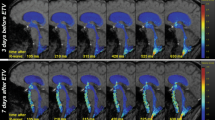Abstract
Cerebral aqueductal stenosis is one of the most common causes of congenital and acquired hydrocephalus, but the etiology, pathophysiology and cerebrospinal fluid (CSF) dynamics of aqueductal stenosis have yet to be clarified. Utilizing cardiac gated cine magnetic resonance (MR) imaging, we evaluated aqueductal configuration and pulsatile motion of brain and CSF flow stimulated by cardiac pulsation in five patients with nontumoral aqueductal stenosis. Cine MR of four cases revealed obliteration of the aqueduct by thickening mesencephalic tectum, turbulent CSF flow in the III ventricle, and absence of flow-related signal void, which in all normal cases indicates CSF movement within the aqueduct. In the remaining fifth case, with proximal dilation of the aqueduct resulting from thinning of the tectum, distortion of caudal (distal) tectum related to pulsatile motion of the brain caused funnel-like narrowing of the aqueduct, leading to incomplete obstruction and the absence of upward CSF flow during diastole.
Similar content being viewed by others
References
Atlas SW, Mark AS, Fram EK (1988) Aqueductal stenosis: evaluation with gradient-echo rapid MR imaging. Radiology 169:449–453
Barkovich AJ, Newton TH (1989) MR of aqueductal stenosis: evidence of a broad spectrum of tectal distortion. Am J Neuroradiol 10:471–476
Bickers DS, Adams RD (1949) Hereditary stenosis of the aqueduct of Sylvius as a cause of congenital hydrocephalus. Brain 72:246–262
Bourneville M, Noir J (1900) Hydrocephalie. Prog Med 12:27
Dandy WE (1945) Diagnosis and treatment of strictures of the aqueduct of Sylvius. Arch Surg 51:1–14
Hirsch JF, Hirsch E, Sainte Rose C, Renier D, Pierre-Khan A (1986) Stenosis of the aqueduct of Sylvius: etiology and treatment. J Neurosurg Sci 30:29–39
Jellinger G (1986) Anatomopathology of non-tumoral aquedutal stenosis. J Neurosurg Sci 30:1–16
Kemp SS, Zimmerman RA, Bilaniuk LT, Hackney DB, Goldberg HI, Grossman RI (1987) Magnetic resonance imaging of the cerebral aqueduct. Neuroradiology 29:430–436
Lee BC (1987) Magnetic resonance imaging of peri-aqueductal lesions. Clin Radiol 38:527–533
McMillan JJ, Williams B (1977) Aqueductal stenosis: case review and discussion. J Neurol Neurosurg Psychiatry 40:521–532
Novetsky GJ, Berlin L (1984) Aqueductal stenosis: demonstration by MR imaging. J Comput Assist Tomogr 8:1170–1171
Nugent GR, Al-Mefty O, Chou S (1979) Communicating hydrocephalus as a cause of aqueductal stenosis. J Neurosurg 51:812–818
Oppenheim H (1900) Über eine Bildungsanomalie am Aqueductus Sylvii. Monatsschr Psychiatrie Neurol 7:177–178
Quencer RM, Donovan MJ, Hinks RS (1990) Cine MR in the evaluation of normal and abnormal CSF flow: intracranial and intraspinal studies. Neuroradiology 32:371–391
Robertson IJA, Leggate JRS, Miller JD, Steers AJW (1990) Aqueduct stenosis: presentation and prognosis. Br J Neurosurg 4:101–106
Schechter MM, Zingesser LH (1967) The radiology of aqueductal stenosis. Radiology 88:905–916
Sherman JL, Citrin CM, Bowen BJ, Gangarosa RE (1986) MR demonstration of altered cerebrospinal fluid flow by obstructive lesions. Am J Neuroradiol 7:571–579
Sherman JL, Citrin CM, Barkovich AJ, Bowen BJ (1987) MR imaging of the mesencephalic tectum: normal and pathologic variations. Am J Neuroradiol 8:59–64
Woollam DHM, Millen JW (1953) Anatomical considerations in the pathology of stenosis of the cerebral aqueduct. Brain 76:104–112
Author information
Authors and Affiliations
Rights and permissions
About this article
Cite this article
Kadowaki, C., Hara, M., Numoto, M. et al. Cine magnetic resonance imaging of aqueductal stenosis. Child's Nerv Syst 11, 107–111 (1995). https://doi.org/10.1007/BF00303815
Issue Date:
DOI: https://doi.org/10.1007/BF00303815




